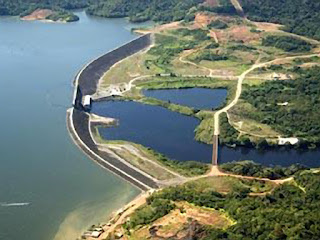 |
| Suriname: The Brokopondo dam at Afobaka |
It must be noted that several governments, especially in Latin America and Africa, have been receptive to the negative images and have adopted hostile policies towards MNCs.
However, a careful examination of the nature of MNCs and their operations in the Third World reveals a positive image of them, especially as the allies in the development process of these countries.
Even as MNCs may be motivated primarily by profits to invest in the Third World, the morality of their activities in improving the material lives of many in these countries should not be obscured through miss-perceptions and negative publicity usually circulated by corrupt local governments.
"It electrified this South American country even as it drowned a jungle, so the 1.2-mile-long dam Alcoa built here to harness the Suriname River is more than stone and turbines. It’s a symbol, in this tropical land of 560,000, of progress, trauma and a global company’s ability to dominate a little country’s landscape and society.
Now the Alcoa Corp. is leaving Suriname, and the Afobaka Dam’s future rivets everyone from the capital’s dealmakers to the forest’s subsistence farmers.
In a country just north of the equator that would fit within a combined Pennsylvania and West Virginia — a country that’s already in a downturn locals call “the crisis” — Alcoa’s decision to permanently end mining and refining has delivered a resonating blow.
Alcoa, the aluminum company founded in Pittsburgh in 1888 that eventually spanned six continents, set up shop here in 1916 when it found bauxite beneath the jungle floor. Cutthroat conditions in the global aluminum market compelled a shutdown in November 2015.
Halfway through that century, Alcoa finished the dam, flooding a forest people’s heartland but also jolting a plantation-based economy into the industrial age. Alcoa created mammoth mining and refining sites and raucous river towns, building a middle class while toughing out a nation’s independence, civil war and an unstable government.
Alcoa found in Suriname, circa 1916, “an almost forgotten and impoverished Dutch colony … which had to look forward to a future without a glimmer of hope,” according to a glossy, celebratory magazine the company produced in late 2014.
It was a land of subsistence farms and wild rubber extraction, plus “colonial plantations” producing cocoa, coffee and sugar. In Alcoa’s first half-century there, the company mined bauxite to the east and south of the capital and sent it abroad, by boat, for processing.
In 1958, the company, the local minister-president and the Dutch governor agreed on a plan to power an ore-to-aluminum industrial complex and signed the 75-year Brokopondo Agreement, named for the town just north of the proposed dam site.
From 1959 through 1965, Alcoa built the Afobaka Dam, and in Paranam a refinery to turn bauxite into alumina, and a smelter to convert that to aluminum ingots. The plans were crafted “on the drawing table of Alcoa’s Engineering Department in Pittsburgh,” according to a company history of the project.
The lengthy Brokopondo Agreement contained just one sentence about the 6,000 people living in 43 villages just upstream of the dam — leaving it to the government to “remove the population, the buildings and other property from the reservoir area.”
The lengthy Brokopondo Agreement contained just one sentence about the 6,000 people living in 43 villages just upstream of the dam — leaving it to the government to “remove the population, the buildings and other property from the reservoir area.”
The 1958 agreement gave Suriname’s government a fraction of the dam’s cheap electricity priced at 0.4 cents per kilowatt hour. But circumstances changed in 1999 when Alcoa closed the smelter, a big user of the dam’s electricity.
Although many say the smelter’s small size and environmental issues were the reasons for the shutdown, there was a nagging suspicion among some that Alcoa had another motive.
Henk Ramdin, Suralco’s general manager until retiring shortly before the smelter was shuttered, said many employees at the time believed the company could make more money selling the power than it could making aluminum.
“They didn’t say it openly, but I could feel it,” Mr. Ramdin recalled.
An Alcoa spokesman wrote that such decisions are based on “a comprehensive evaluation of market conditions, regulatory certainty, and capital requirements,” but declined to be more specific.
The dispute over the dam and electricity pricing came to head in October 2015, when Alcoa and Suriname’s current minister of natural resources signed a nonbinding memorandum of understanding outlining proposed terms for Alcoa’s departure.
Alcoa agreed to clean up its mines and industrial sites to U.S. standards, to consider eventual mining of bauxite in western Suriname, and to give the dam to the country’s government at the end of 2019 — 13 years before the Brokopondo Agreement ended."
For the complete report click here: A struggling country's past and future shaped by Alcoa and its aluminum | Pittsburgh Post-Gazette